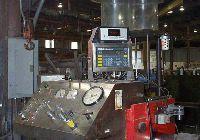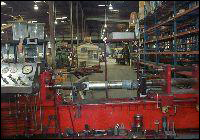PT&P has two test machines specifically designed for testing snubbers for piping applications, one for routine testing of hydraulic snubbers, and a more sophisticated machine that can perform a wide range of tests on both hydraulic and mechanical snubbers.
PT&P STADAS Snubber Test Machine
The STADAS is a trailer mounted snubber test machine manufactured by Paul-Munroe Inc., California. This computer controlled, hydraulic test machine is used to test the performance of mechanical and hydraulic snubbers ranging in size from 150 lb. to 135,000 lb. The STADAS may also be used to verify snubber conditions at the point of manufacture, or during an outage (refueling) at the plant site.
The STADAS machine is capable of controlling a test, following any load sequence needed. It can then plot the test results immediately, and save the results to disk for future reference.
The main frame of the STADAS machine is comprised of two drive cylinders, which supports the snubber being tested. The smaller drive cylinder is used for snubbers rated to 6000 lb., and the larger drive cylinder is used for snubbers rated up to 150,000 lb. Each drive cylinder is equipped with an electro-hydraulic servo-valve, load cell and connections to the hydraulic system.
The Hydraulic Snubber Test Machine is mainly used to perform testing for hydraulic snubbers, it has a similar test bed like the STADAS machine, however, it is not computer controlled. It is adequate to perform all the tests normally required for hydraulic snubbers, such as quality control and periodic tests that are sometimes required as part of plant maintenance programs. Mechanical snubbers can also be tested on this machine, but due to the complication of the process, mechanical snubbers testing is usually performed on the STADAS machine.
The Objective
The objective of the snubber cycle test is to (1) display the normal wear and tear for a snubber over an extended period of time, and (2) display the resistance to an abrupt disturbance.
What We Do
We test snubbers at their two modes of operation. We expect snubbers, at high rates of loading, especially impact, to provide very high resistance to movement. At low speeds we expect the snubbers to provide very low resistance to movement.
After Completion
Once the test is completed, the engineers will discuss the data reported and propose alternatives that will aid the value in meeting the drag force’s common criteria of 2% or less than the rated load.


For more details view our Recent Snubber Testing Press Release or submit your inquiries via the online inquiry form or contact us at info@pipingtech.com
